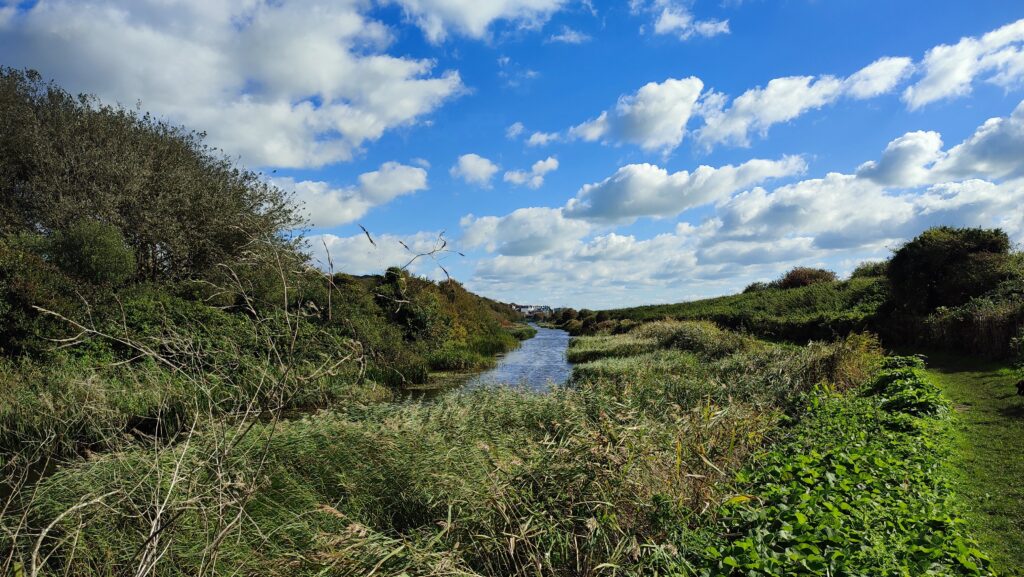It’s 2019 and The Fountain Inn at Seabrook is packed. There is standing room only but the people haven’t come to see live music or football. They have come to witness one of the most important district council meetings for years… to decide whether planning permission should be granted for Princes Parade. The atmosphere is tense, the people watching the big screen are almost silent, listening intently to the debate which, in classic council style, was streamed with poor sound quality. At the council itself, the gallery is full – primarily with those that wish to see planning permission denied and the whole idea of building 150 homes scrapped once and for all.
But it is not to be – and in reality the decision is foregone – the pro-development councillors outnumber the rest and despite valiant calls for a rethink, permission is granted. A collective outrage spills out across the district, leaving an entire community in hope that the Save Prince’s Parade campaign would succeed in righting this terrible wrong.
Fast forward to 2024 and the situation is somewhat different. Many of those councillors who approved the scheme lost their seats in the local elections of 2023 – the Princes Parade debacle being a significant factor. Even before the elections, any further progress of the scheme had been put on hold. The reason? Spiralling costs. Eye-watering expenses and the significant financial risk of developing Princes Parade were primary reasons cited by opponents not to pursue the scheme. Nothing has changed and almost any attempt to develop the area for housing remains at best foolhardy.
Any future vision for Princes Parade must therefore consider what is realistically feasible, both financially and in terms of practical considerations of what would be of most benefit to both council and residents. The blind desire to develop at all costs in the hope of making money for the council, consultants, contractors or developers must be resisted and recognised for what it is – doomed to fail!
There is considerable evidence to support the view that such development is financially flawed and that the scheme would have created a money pit capable of bankrupting the council itself. A redacted version of the financial viability report, conducted by Betteridge and Milsom, was eventually released (following a freedom of information request!) in 2018. It should not be forgotten that the scheme’s only popular feature was to provide a new swimming pool for the Hythe area and the report compared the cost of building at Princes Parade with Nickolls Quarry (now more commonly known as Martello Lakes). I do not think it far-fetched to say that the report was biased, inflating the costs of building at Nickolls Quarry while downplaying the difficulty, uncertainty and exorbitant cost of developing Princes Parade. As a result, Nickolls Quarry was never seriously considered and no actual studies commissioned. When asked why, the then council leader, David Monk, said that he didn’t want to waste money commissioning reports on an unsuitable site. Clearly he had no qualms about spending millions on a far more risky scheme. There are several reasons why that scheme remains financially unviable.
- Princes Parade borders the Royal Military Canal which is an scheduled ancient monument – the same designation as Stonehenge and is historically hugely important. The National Planning Policy Framework says that substantial harm or loss of scheduled ancient monuments should be wholly exceptional. In the case of Princes Parade it was the setting of the canal which was at risk of harm. Unfortunately Historic England did not go so far in their objection as to say that the harm would be ‘substantial’. The design and layout released by Holloway Studios shortly before the plans were “paused” however, could easily be described as harming the setting substantially!
- The site is contaminated – a detailed report of over 400 pages undertaken by BAM identifies contamination across the site, notably including asbestos and PAH’s (a pollutant which can have serious effects on human health such as causing cancer, breathing problems and kidney/liver damage). Despite extensive bore holes being drilled, some could not be fully accessed meaning there are still some unknowns in the analysis. BAM protected themselves by ensuring the financial risk of undiscovered substances or difficulties remained with the council. Options to remediate the land were explored in the reports. The best, removal of the waste, was dismissed as too costly, meaning all that was left was the inferior idea of covering the contamination over with clean soil. Any construction below a shallow depth would run the risk of exposing contamination and the extensive piling that was planned (necessary to support the new road and buildings) risked drawing up pollutants. Extensive continuous monitoring, to ensure public safety, would further add to the costs.
- Princes Parade sits between the canal on one side and the sea on the other. Drainage for any development there would be not only complex but also expensive. The Council and its consultants wrestled with the difficulties of designing a suitable system that would not pollute the canal. The Environment Agency raised many objections and a variety of different plans were put forward including the chosen “solution” – which the Environment Agency said was only “just about viable” – discharging surface water to the sea, via the beach.
In reality, many were sceptical that any scheme would be without recurring issues, risking either polluting the Royal Military Canal or compounding the flood risk already present. None were without potential for harm and all would be costly. Drainage implementation, both surface and foul water, would be an issue for the development because it would involve disturbance of the deeper contaminated landfill over an extensive area. - Climate change will likely exacerbate issues with drainage – the clear evidence for heavier rainfall, higher tides and more extreme weather events in the future is well documented. The position of Princes Parade at the end of the Royal Military Canal as it flows into the sea at the bottom of a valley is laden with future risk and was the reason that the residential buildings included sacrificial ground floors. Would there be any certainty that, once built, residents would be able to obtain insurance at reasonable cost – and if not, what impact would that have on interest in buying these highly expensive flats? A white elephant blotting the landscape!
- The notion of creating a new access road within metres of the RMC and supporting it as it rests on top of unstable contamination (necessitating more piling?) was always problematic. As above, complexity equals cost.
In 2016, over two years before it was released to the public, a report was produced by consultants Design South East (d:se). It was so damning that it’s not surprising it wasn’t released for general consumption and it is likely that proponents of the scheme hoped it would be quietly forgotten about. Here are a few lines from it:
● Regarding housing: “The site has extraordinary development costs.”
● Regarding realigning the road: “While we can admire the ambition of this plan and see its benefits, it is a very expensive move, adding costs to the development… and potentially creating as many problems as it solves… The road alignment decision is a poor response to context and the decision to spread the development across the site needs to be re-examined.”
● Of the scheme in general: “Although it has sometimes been used insensitively, in the past its open character is valuable. The views from the community around Seabrook Road to the beach and sea and back the other way are valuable as is the view down to the site from the higher parts of Seabrook. We note the local opposition and the concerns of Historic England.”
With these criticisms in mind, we can see that not only is developing Princes Parade unpopular, it is also fraught with uncertainties and spiralling costs which would undoubtedly be a feature of any such scheme.
So where does this leave us?
- Site contamination makes any development prohibitively expensive. Despite the surveys there remains significant uncertainty and that represents financial risk for the council as landowner.
- Any increased public access will come at a cost. Sadly, the dredging of the RMC and the dumping of spoil onto Princes Parade in the early 2000s led to the removal of public access to the site. If, for example, a pathway were desirable through the site, there is the potential for selected areas to be covered with clean topsoil to enable fenced access. Paragraph 8.4 of this report explores the idea of allowing restricted access through the site.
- The value in terms of wildlife and biodiversity remains underappreciated in the wider community. Improving and managing the site for wildlife could help improve the perception of the site from a worthless waste ground to a sensitively managed area with the currently available walks around it. Perhaps some information boards featuring environmental interest in addition to heritage information would increase its attractiveness, encouraging visitors and supporting local business by creating a wildlife and heritage “destination”.
- Supporting Seapoint Canoe Centre in their desire for a suitable building.
- Continuing the provision of the play area on the current site at the eastern end.
Another option for the council to consider may be carbon credit and/or biodiversity net gains schemes which would create an inherent monetary value for the site while assuring it remains open, wild and with potential for increasing its value for wildlife.
In general, Princes Parade is simply not suitable for the kind of urbanisation for which planning permission was granted. The options for future use are therefore somewhat limited both practically and financially. However, this does not mean that Princes Parade is worthless, in fact it is its wildness and open aspect which creates an intrinsic value. Blue/green space and nature are vital for wellbeing and the value of spaces such as this should not be underestimated.
It is these final points that we should be encouraging the council to explore at the upcoming consultation. This will be one consultation which is worthwhile engaging with and commenting on. Details will be published on this website when they are released by FHDC and I hope you will give a strong mandate to councillors to protect this land in perpetuity.


So well detailed and explained! The preservation of the land is now in the hands of the council and people of Hythe. It is mainly a Wildlife haven and should remain as such with replanting of trees. A record of all animals, insects, reptiles, birds should be put in place with all acquired sources to be used as a small learning centre for visitors.